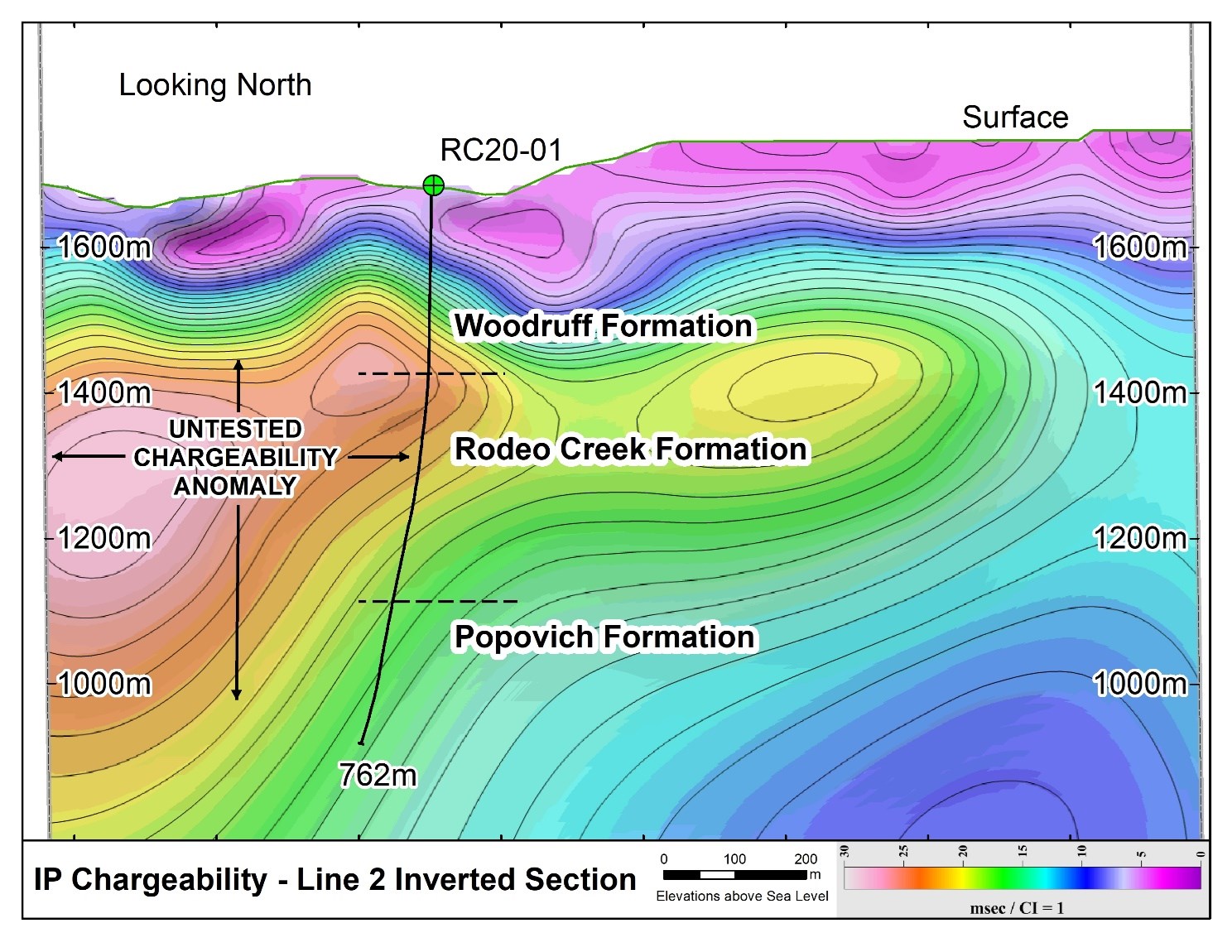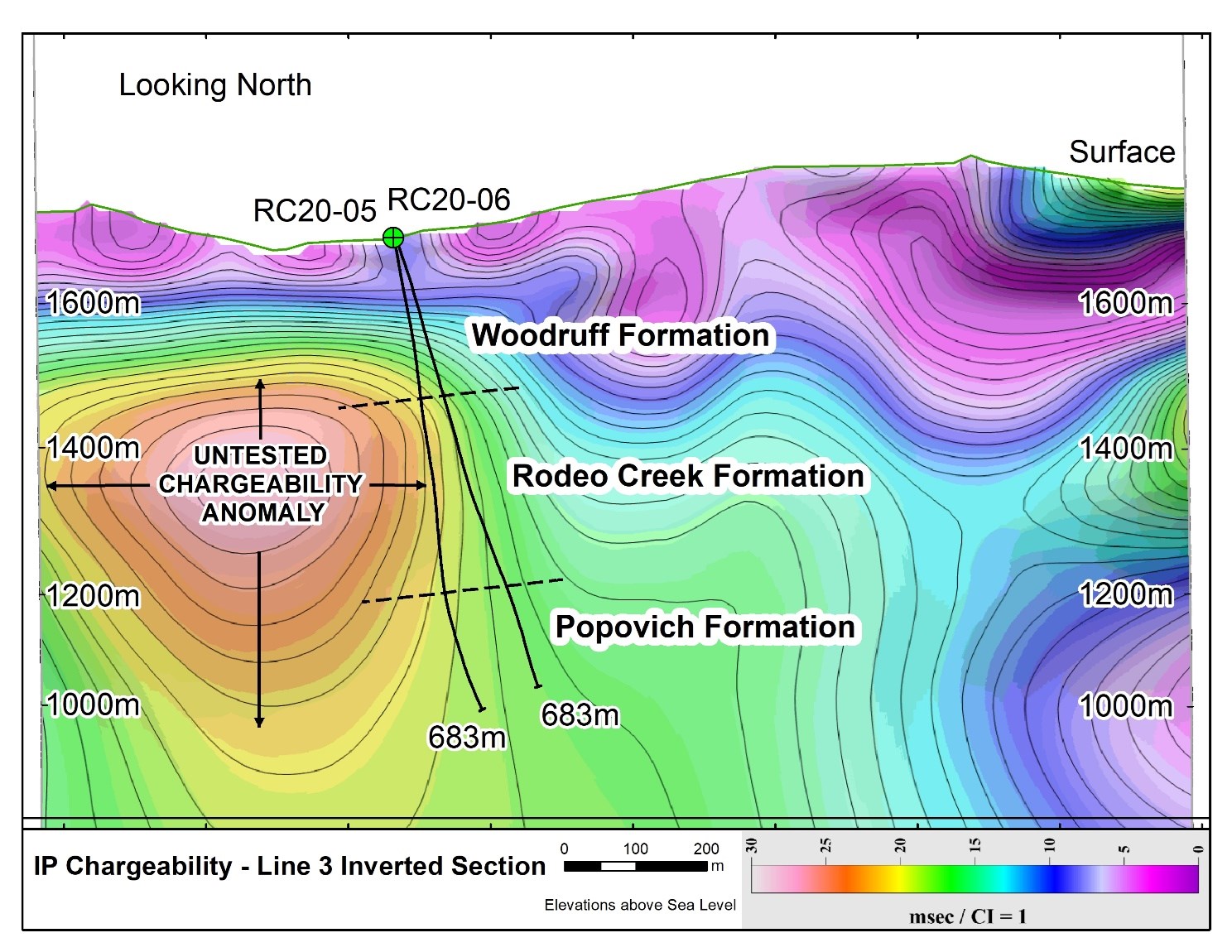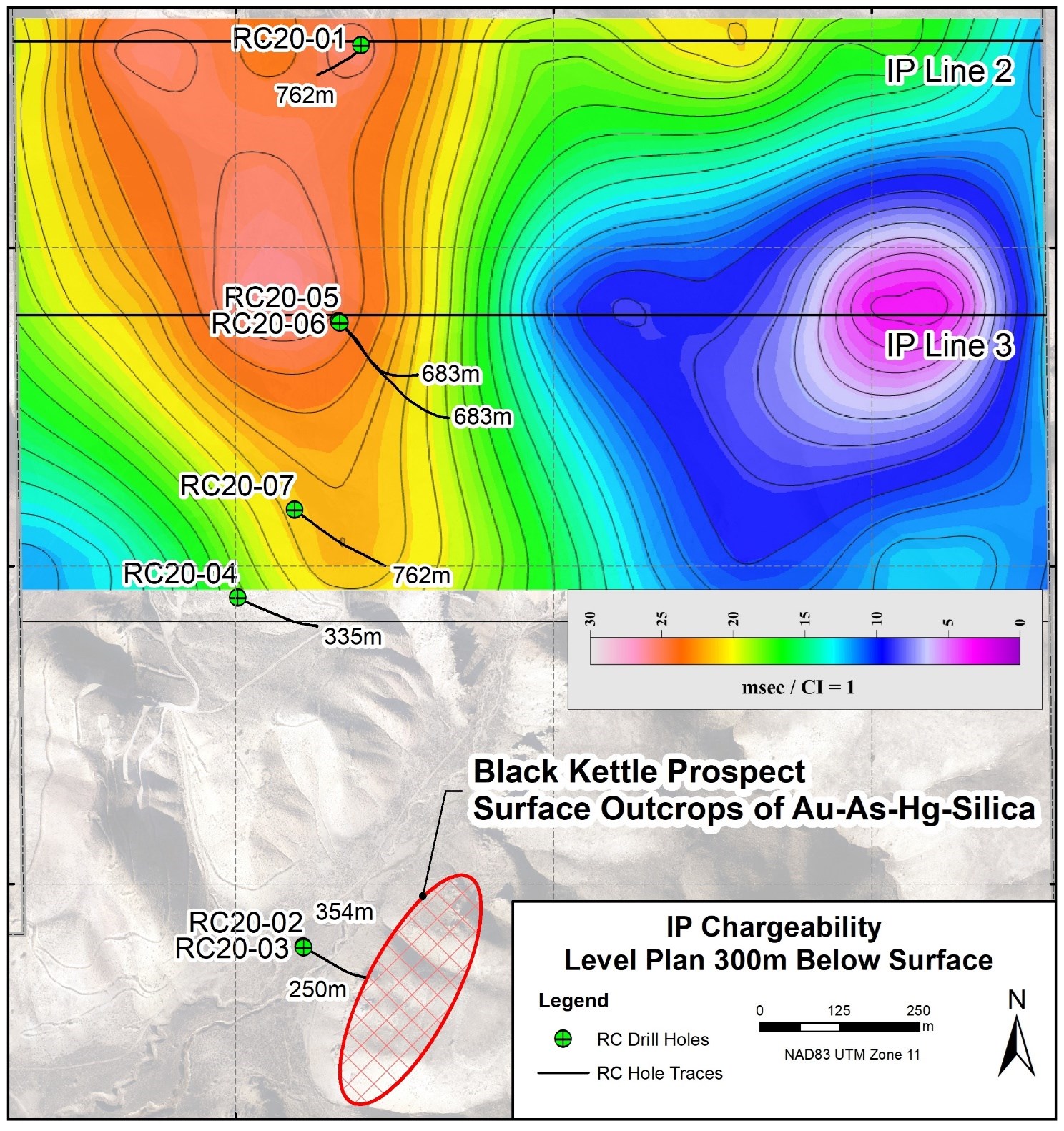First Vanadium Identifies The Root System to Its Carlin-Type Gold System on the Carlin Gold Trend – Large and Untested
Vancouver, British Columbia–(Newsfile Corp. – March 15, 2021) – First Vanadium Corp. (TSXV: FVAN) (OTCQX: FVANF) (FSE: 1PY) (“First Vanadium” or the “Company”) is pleased to provide initial results from its Induced Polarization (IP) survey over the gold system on its Carlin Gold-Vanadium Property on the Carlin Gold Trend of Nevada. Dave Mathewson, Geological Advisor and Jim Wright, former Newmont senior geophysicist, have identified part of the large north-south oriented root system to the much larger sulfide plume related to the gold system by IP. The Company’s IP survey to date demonstrates the large root system with a strike length of at least 1.2 kilometres (0.75 miles) long (north-south), up to 750 metres (2460 ft) wide (east-west) and >500 metres (>1640 ft) vertically. The root system is open-ended to the north and south and remains untested by drilling to date.
IP was largely used in the discovery of the Betze, Screamer, Rodeo, Griffin and Deep Star gold mines on the Carlin Gold Trend. Root systems of Carlin-type gold systems generally contain higher sulfide content (detected by IP) and higher-grade gold portions of Carlin systems.
Figure 1: Line 2 IP Chargeability Inverted Section – untested root system/Chargeability anomaly and RC20-01
Dave Mathewson states, “This is an exciting development. Our IP survey solidifies and advances our thinking significantly, forming a new stage of probability. Our drilling results coupled with the IP survey is a powerful combination of exploration tools to vector into the hot spots comprising the gold feeder zones of the system. The positive surprises from both drilling and IP demonstrate the system is bigger than anticipated and thus the significance of the system and the importance of smart vectoring tools in such a large system. The one exploration tool complements and enhances the other. The geology (rock type, breccias and depths) and extent and zonation of sulfides, multi-element mineralization and alteration found in drilling allowed for best design criteria to set-up the IP survey, a more reliable interpretation of the IP results and better vectoring into the more favourable portions of the root system. The IP now shows the overall size, shape and location of the root system and points to higher sulfide portions. I am very encouraged with these results and keen to test the root system with our next stage of sharpshoot drilling.”
According to Jim Wright, geophysicist, the IP data quality is excellent with clear depth penetration in the order of 800 m (2625 ft), giving rise to a good solid moderate to strong chargeability anomaly, typical of abundant sulfides. Average chargeability amplitudes (a reflection of disseminated sulfide content) are in the 25-30 millisecond range. The current drilling which shows to be off the shoulder of the anomaly contains between 3-10% sulfides, therefore, the root system is interpreted to likely have much stronger sulfide content. For context, 3-10% sulfide content is strikingly similar to typical sulfide amounts within and around the major gold mines in the Carlin Trend. And, typically, the higher the sulfide content, the higher the gold values tend to be in the system. The IP survey also produced coincident strong resistivity lows likely caused by argillic alteration.
Figure 2: Line 3 IP Chargeability Inverted Section – note untested root system relative to RC20-05 and 06
Figures 1 and 2 are two of the east-west IP sideview cross-sections or Inverted sections, 400m apart, that demonstrate the core of the untested chargeability anomaly or root system with depth, and its proximity to drilling. The upper contact of the lower plate Rodeo Creek and Popovich units are interpreted from drill data. The anomaly coincides with Rodeo Creek and Popovich units. Rodeo Creek and Popovich units are the host rocks to the majority of the big, and also the compact high grade gold deposits and mines in the Carlin Trend.
Jim Wright has produced a 3D model of the open-ended lengthy anomaly from the three lines of IP collected to date (Line 2, 3 and 4). To best demonstrate the anomaly within Rodeo Creek rocks, a slice of the 3D model, 300m below the surface is draped over the surface in Figure 3 with the context of the 1.4km (0.9 miles) stretch of drilling and surface outcrops of gold to the south. Future IP lines will fill-in to the south and north on this figure, subsequently. This figure demonstrates the north-south length (>1.2km), width (up to 750m) and strength (moderate-strong) of the anomaly that is open-ended both north and south. Clearly, the root system has not been tested by drilling which test just east of the anomaly. The southern projection of the root system projects to surface exposures of gold-arsenic-mercury near holes RC20-02 and 03, giving support to the southern continuation of the root system. Holes RC20-02, 03 and 04 did not reach the desired depth.
Figure 3: IP Chargeability Level Plan 300m Below Surface – large root system/Chargeability Anomaly in orange
On February 2, 2021, management reported visual observations from the remaining 4 drill holes, RC20-04 through RC20-07, declaring “the target is evolving very nicely with many positive qualities of substance. Drilling to date has delivered proof of a gold system with widespread solid attributes, similar to deposits and mines on the Carlin Trend; favourable depth, rock host, size, and intensity and extent of brecciation, sulfides, pathfinder metallization, and alteration (silica and dolomite).” Dave Mathewson continues, “The expression of the system is very strong in the holes and very importantly, in the right set of rocks. There is no doubt these positive features reflect the proximity of these holes to the root system now known from the IP program. ”
Assays and geochemical analyses have now been received for the remaining 4 holes. Reflecting proximity to the root system, all typical pathfinder elements used to define a Carlin gold system are strongly present in these holes; arsenic, antimony and mercury and to a lesser extent thallium, silver, barium and zinc. And, the zonations displayed from these pathfinder elements point favourably immediately westward towards the root system. Other pathfinder elements, such as calcium and magnesium are expressing substantial continuous dolomite alteration in holes RC20-02, 03, 04 and 07; hole RC20-04 has 320 m (1050 ft) of continuous dolomite altered rock. Holes RC20-05, 06 and 07 show a 100m (330 ft) long section of strong quartz-dolomite alteration focused either side of Rodeo Creek-Popovich contact.
Gold is found in mild levels (6-45 ppb Au) in all four holes in Woodruff, Rodeo Creek and Popovich units over extensive portions of each hole and correspond to collapse breccia sections. Between 35-55% of the entire hole length of RC20-01, 02, 05 and 06, and over 20% of the entire hole length of RC20-07 average 10 ppb Au, indicative of the edges of a large gold system. These lengthy elevated sections display a somewhat stratified shallow dipping lateral continuity between all seven holes completed to date. These same sections have corresponding elevations in arsenic (300-1550ppm), antimony (25-87ppm) and mercury (5-420ppm), demonstrating extensive fluid migration into the stratigraphy from the west (the root system).
Dave Mathewson states, “These rock units that we are drilling, Rodeo Creek and Popovich, are the best rocks along the Carlin Trend to host gold deposits and the system is strongly evident on our property from IP and drilling to date. We continue to gain a much clearer picture of the system and targeting. Additional IP lines will just add to the picture of the root system. Furthermore, I have seen in other deposits on the trend, dramatically improved gold values over short distances (50-100m), the closer in proximity one is to the main conduit or root system. Thus, we plan to trace these extensive elevated gold sections in our holes back to the root system for improved gold grades. I am very encouraged with these assay and geochemistry results and keen to test the root system with our next round of sharpshoot drilling.”
About First Vanadium Corp.
First Vanadium has an option to earn a 100% interest in the Carlin Gold-Vanadium Project, 6 miles south from the town of Carlin, Nevada and Highway I-80. The Project lies in the Carlin Gold Trend. Approximately 9 million ounces comprised of multiple gold deposits, including past producing mines, are present near the FVAN property (5-15km). The Carlin Gold-Vanadium Project also hosts the Carlin Vanadium deposit.
ON BEHALF OF FIRST VANADIUM CORP.
per: “Paul Cowley”
CEO & President (778) 655-4311 pcowley@firstvanadium.com www.firstvanadium.com
Technical disclosure in this news release has been reviewed and approved by Dave Mathewson, a Qualified Person as defined by National Instrument 43-101, and Geological Advisor to the Company.
Neither the TSX Venture Exchange nor its Regulation Services Provider (as that term is defined in policies of the TSX Venture Exchange) accepts responsibility for the adequacy or accuracy of this release.
Forward-looking information
Certain statements in this news release constitute “forward-looking” statements. These statements relate to future events or the Company’s future performance and include the Company’s ability to meet its obligations under the Access and Mineral Lease Agreement and the conditions required to exercise in full its option to acquire the Carlin Vanadium project, to finance and drill test the interpreted gold target model and to encounter potential gold zones shown in the gold model. All such statements involve substantial known and unknown risks, uncertainties and other factors which may cause the actual results to vary from those expressed or implied by such forward-looking statements. Forward-looking statements involve significant risks and uncertainties, they should not be read as guarantees of future performance or results, and they will not necessarily be accurate indications of whether or not such results will be achieved. Actual results could differ materially from those anticipated due to a number of factors and risks. Although the forward-looking statements contained in this news release are based upon what management of the Company believes are reasonable assumptions on the date of this news release, the Company cannot assure investors that actual results will be consistent with these forward-looking statements. The forward-looking statements contained in this press release are made as of the date hereof and the Company disclaims any intention or obligation to update or revise any forward-looking statements whether as a result of new information, future events or otherwise, except as required under applicable securities regulations.
To view the source version of this press release, please visit https://www.newsfilecorp.com/release/77241



